
Gunnera, Brazilian giant rhubarb: planting and care
Contents
Gunnera, in a nutshell
- Gunnera, or Brazilian giant rhubarb, is an imposing perennial of wet places that evokes an oversized rhubarb, but there are also dwarf groundcover species such as Gunnera magellanica.
- This fascinating plant with a prehistoric appearance, bearing red or greenish spikes pointed skywards, can sit in a container or cover banks of a pond or stream.
- Moderately to slightly hardy, protect the stump of the giant Gunnera in winter by covering it with its leaves and give it a humus-rich substrate.
A word from our expert
Gunnera manicata, also known as Brazilian giant rhubarb or Gunnera brasiliensis, is a perennial plant to say the least “monstrous”, particularly prized beside ponds and other water features for the luxuriance of its foliage and its extremely graphic habit. Its imposing, rugged presence evokes image of a primitive swamp world where tree ferns and giant dragonflies once coexisted. The plant seems from another age, disproportionate, with giant petioles studded with thorns that can exceed human height and project rough palmate laminae 2 to 3 m in diameter toward the light, accompanied by enormous brush-like inflorescences emerging directly from the ground.
Strangeness of this perennial does not prevent it being relatively easy to grow. Native to tropical and subtropical mountains of Brazil and Colombia, it adapts very well to temperate zones enjoying a mild, humid climate such as along Atlantic and English Channel coasts, even becoming invasive in British Isles. But because it is deciduous, simply covering the stump with its enormous leaves allows it to withstand frosts down to -15 to -20°C. It has been cultivated in Vienna botanical garden for decades with simple, rudimentary protection. Genus is very diverse so there are also mat-forming perennials only 10 cm high such as Gunnera magellanica, found up to 3000 m altitude in Andes.
Thanks to sym symbiosis established with cyanobacteria, Gunnera manicata is able to capture nitrogen from air which explains its exceptional growth. This plant in all cases requires fresh to moist but well-drained soil, as on banks of a pond. It can quite easily be planted in a large deep pot watered regularly to adorn a terrace for a few years. In an exotic-style garden, it pairs well with tree fern (Dicksonia antartica) or palms that like or tolerate moist soils such as Sabal, and even Trachycarpus.
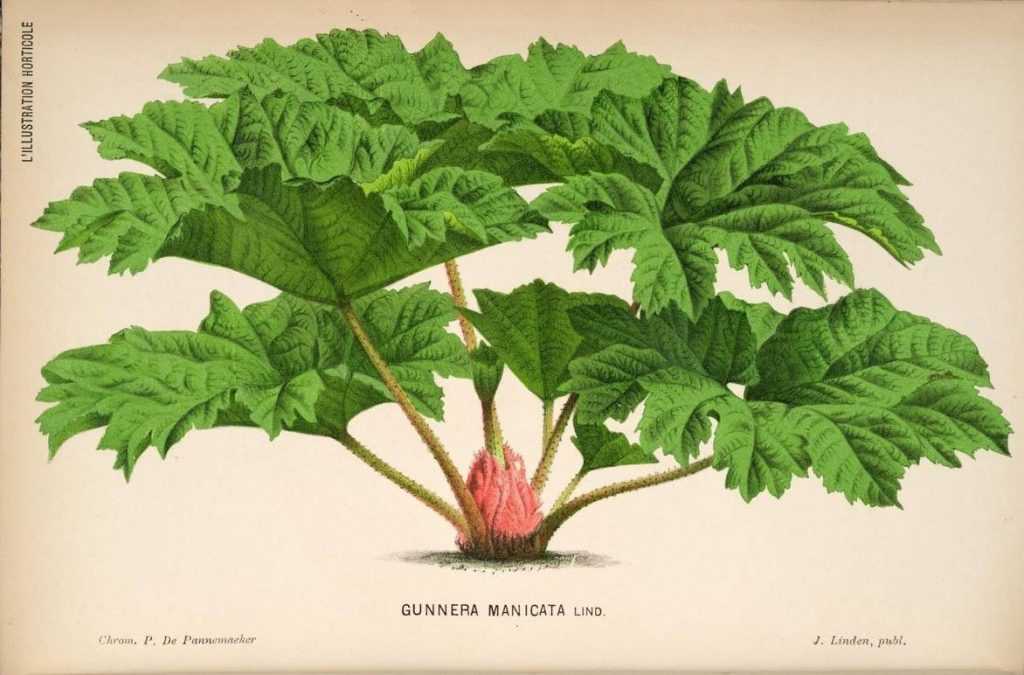
Gunnera manicata – botanical illustration
Description and botany
Botanical data
- Latin name Gunnera
- Family Gunneraceae
- Common name Brazilian rhubarb, Brazilian gunnera, Chilean gunnera
- Flowering between May and August
- Height between 0.10 and 3 m
- Sun exposure sun or partial shade
- Soil type deep, rich, fresh to moist but not waterlogged, not too calcareous
- Hardiness average to good (-7 to -20 °C)
Genus Gunnera includes nearly 70 species of rhizomatous perennials from southern hemisphere, spanning temperate regions of Africa, Madagascar, South America and Australia–New Zealand–New Guinea. These plants colonise humid but well-aerated sites such as riverbanks or high-altitude wet meadows. Genus Gunnera gives its name to family Gunneraceae, which sometimes also includes genus Myrothamnus of two species.
Gunnera manicata, native to mountains of Brazil and Colombia and still called giant Brazilian rhubarb, has become almost a classic at pond margins in ornamental gardens for its graphic, exotic look, to the point of escaping gardens and naturalising in Ireland for example.
From a large rhizomatous rootstock bearing a large fibrous red bud come in spring robust spiny-studded petioles reaching 2–3 m long, which open like an inverted umbrella into a spectacular rounded, dentate lamina. Rootstock, this thick, stout stem that spreads horizontally at shallow depth, produces adventitious roots that shelter colonies of cyanobacteria able to fix atmospheric nitrogen. Leaves are alternate, with stipules and palmatilobate, traversed by very marked dichotomous veins that give a corrugated appearance and turn golden-green when lit by sun rays. Gunnera manicata can form a clump 3 m high and 5 m wide, with leaves 2–3 m across in favourable conditions and can even become invasive. Chilean species Gunnera tinctoria (syn. chilensis), slower-growing, forms a less vigorous, slightly more compact clump rarely exceeding 1.5–2 m in any direction. It is often confused with manicata, which is more difficult to propagate. Its foliage is more elongated, more deeply cut and coarsely dentate and bears a more red petiole with rough spines. Gunnera insignis, from Costa Rica, resembles manicata but with very decorative bright red veins and inflorescences. Gunnera perpensa is a South African species 50–70 cm high, reminiscent of Petasites fragans. Lamina is kidney-shaped, finely dentate, matt dark green and 15–20 cm wide. To create a superb 10 cm-thick groundcover, consider creeping species such as Gunnera magellanica with its small glossy round leaves that persist in mild climates or Gunnera hamiltonii forming a bronze lace-like carpet topped by red spikes in autumn.
Gunnera generally lose foliage at first frost and fully regrow it the following spring provided soil is rich and fresh and rootstock has not been damaged by frost.
Fleshy fruits are drupes brown, scarlet in G. magellanica and hamiltonii.
Seeds of giant Brazilian rhubarb (G. manicata) rarely reach ripeness in wild and take no less than three months to germinate, besides requiring presence of a bacterium to develop well. This explains why market plants are most often tinctoria, much easier to reproduce in vitro, but sold under name manicata!
Petioles of dye-gunnera (Gunnera tinctoria) are edible unlike those of manicata. They are eaten raw or boiled or used in a cooling decoction by indigenous peoples. Roots of tinctoria, as name indicates, provide black dye for fabrics; their richness in tannic acid also makes them useful for tanning leather.
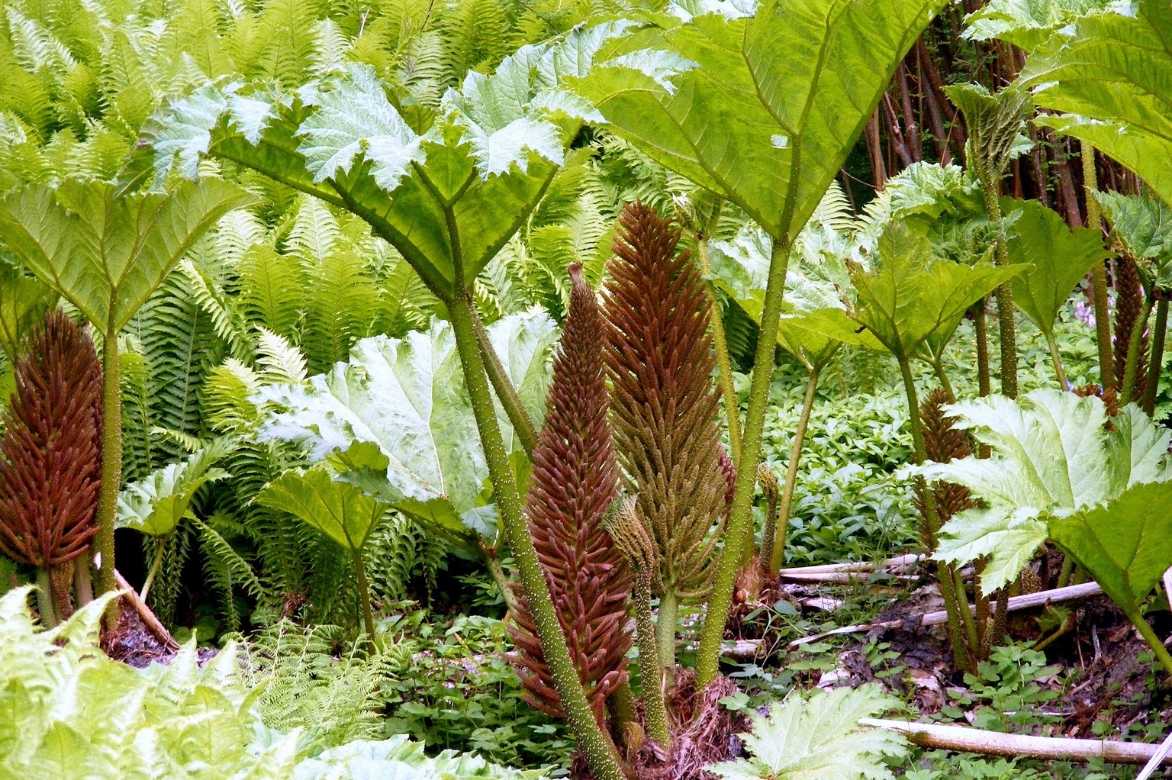
Inflorescences of Gunnera manicata Gunnera manicata
Main varieties of Gunnera
Giant varieties
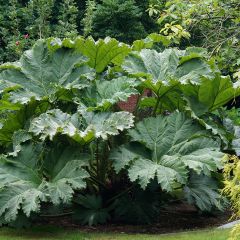
Gunnera manicata - Brazilian Giant-rhubarb
- Flowering time July, August
- Height at maturity 2,50 m
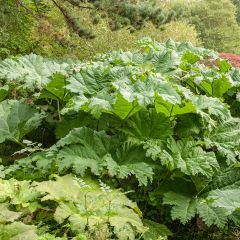
Gunnera tinctoria - Chilean Rhubarb
- Flowering time July, August
- Height at maturity 1,80 m
Mat-forming variety
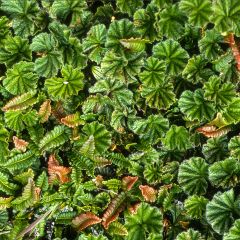
Gunnera magellanica
- Flowering time July, August
- Height at maturity 15 cm
Discover other Gunnera
View all →Available in 3 sizes
Available in 1 sizes
Available in 1 sizes
Planting a Gunnera
Avoid situations that are too hot, dry or exposed to cold or drying wind. Prefer a sheltered, slightly shaded situation during the hottest hours, such as east-facing. The species tinctoria tolerates full sun better than manicata and also withstands a few degrees lower (-5°C instead of -3°C) without protection.
Give Gunnera deep, humus-bearing soil with no excess lime, which remains cool and moist especially during summer. Be careful: water level must not submerge the stump or it will rot.
Stump, with thick protection, can resist temperatures of around -15 to -20°C, provided at least 2–3 years old.
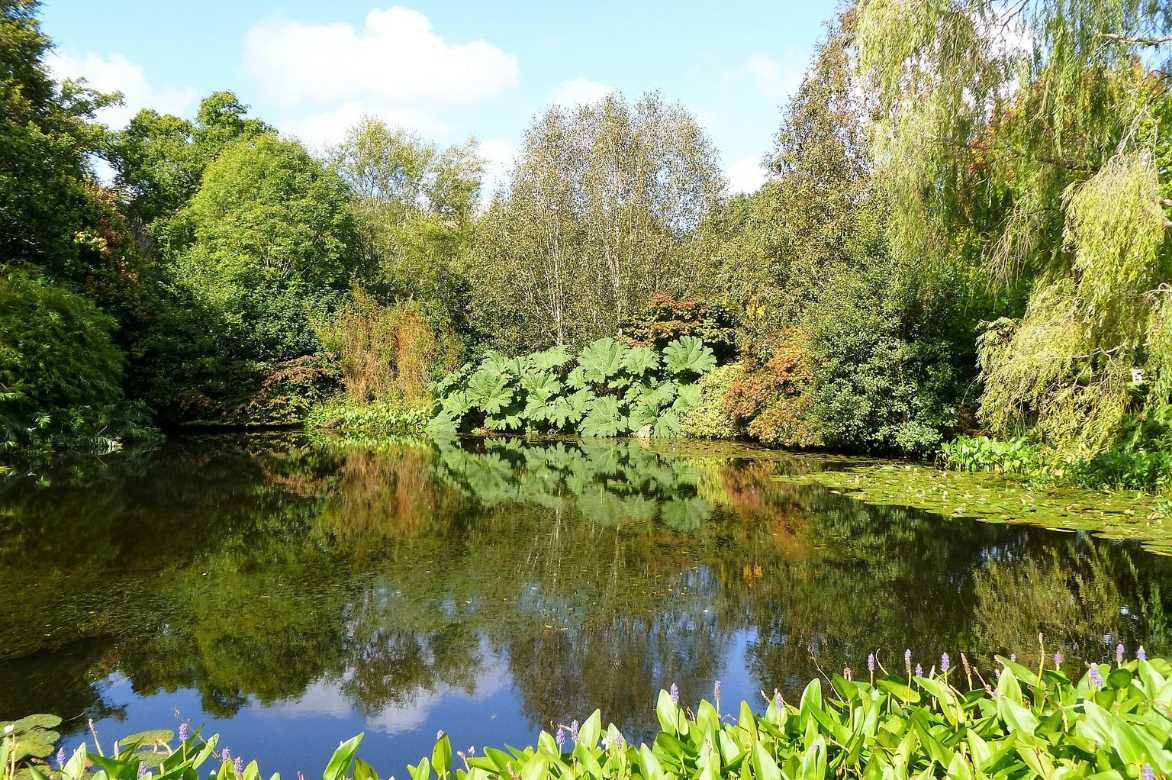
When to plant?
Prefer planting in spring if winter is cold; otherwise autumn is equally suitable.
How to plant?
This plant requires minimal care to ensure a long life: cool soil especially in summer while avoiding waterlogging in winter.
A pond made with a liner does not allow Gunnera roots to draw moisture but it is possible to create a moist pocket on the bank.
- Sink the pot in a bucket of water to thoroughly moisten it.
- Dig a hole of about half a cubic metre: 60 cm deep and about 1.50 m across.
- If soil dries out in summer, line base of pit with a sheet to retain moisture.
- Place 10 cm of gravel then fill pit with clayey or turfy soil, generously mixed with well-rotted compost and manure.
- Plant rootball without burying bud.
- Backfill hole then spread a generous layer of mulch (dead leaves, grass clippings…)
- Water to remove air pockets.
Use a large container fitted with a large saucer always kept full of water to grow Gunnera soilless.
Care
- Moderately hardy, giant Gunneras require protection of the stump under a thick mulch over winter if temperatures fall below -3 to -5°C. In season, the plant grows in cool climates such as Normandy or more continental ones such as Vienna in Austria without problem. This plant does not particularly need heat because in its natural habitat it frequently freezes for more than three months.
- As soon as first frosts arrive, cut the leaves at the base of the petioles. Trim the leaf laminae and place them on the stump until they form a 50 cm thick pile. Lay the heavy petioles on top to stop everything blowing away. With dwarf forms, cover the tapetum with 15 cm of dead leaves. You can also overwinter plants in pots in a frost-free cellar because it does not need light in winter. More information here: How to overwinter a Gunnera. See our video :
- Gunnera requires little maintenance. In addition to leaving Gunnera leaves in place, don’t hesitate to add regular humus in the form of compost or manure to encourage growth and maintain soil freshness unless your Gunnera becomes a little too intrusive.
- In a pot, choose a large container, water very regularly, especially in summer, and give your Brazilian giant rhubarb a slow-release fertiliser in spring and late summer.
- Gunnera is only sensitive to gastropod attacks at the start of the season. Set beer traps or spread ferns or Ferramol granules.

Propagation
Simplest way to propagate is by dividing clump because germination is rather erratic, especially if so‑called cyanobacteria are absent from substrate. Adventitious roots arising from rootstocks do harbour colonies of Nostor or of Chlorococcus that greatly encourage their development and survival, so that in their absence, seed of Gunnera manicata does not germinate while other species of Gunnera require presence of insects. Gunnera tinctoria germinates more readily.
Division of stump
- Separate a piece of rootstock bearing a bud in spring or autumn.
- Replant it immediately in rich, moist substrate.
Sowing
- Collect fruits of Gunnera in autumn and separate pulp from seed.
- Sow seeds immediately in bright mini‑greenhouse at 20–22°C, in compost kept moist.
- Repot seedling in spring into large pot filled with rich substrate.
Uses and associations in the garden
In large areas surrounding a pond or stream, it is easy to complete the flooded area of this prehistoric tableau created by presence of giant Gunnera with large ferns such as Osmunda regalis, Miscanthus giganteus or sinensis ‘Zebrinus’, Himalayan horsetail (Equisetum hyemale) or large swathes of Saururus cernuus for its reptilian aspect. Add colour with bright yellow funnel-shaped flowers of Lysichiton americanus or white flowers of the famous Ethiopian Arum ‘Crowborough’ or scarlet ones of Hibiscus coccineus. Take care to create some lower-growing vegetation areas so as not to completely obscure the pond: some Carex pendula or elata ‘Aurea’, Achillea ptarmica, and a few Myosotis palustris will fill these shores, opening pleasant perspectives onto the tallest plants. Colour will be provided by Hibiscus moscheutos with giant flowers, kaffir lilies and Physostegia virginiana, for example.

Planting idea for wet area: Gunnera manicata, Osmunda regalis, Equisetum hyemale, Saururus cernuus and Miscanthus giganteus
In a more exotic-tropical garden style, pair Gunnera with some arborescent ferns such as Dicksonia antarctica or with palms that prefer or tolerate wet soils such as Sabals, and even Trachycarpus.
Growing giant Gunnera in a very large pot is possible; however plant vigour will be reduced and lifespan shortened.
Gunnera magellanica can carpet stream banks on peaty, wet soil alongside Trollius pumilus and dwarf willows (Salix herbacea – Salix retusa).
→ Discover 5 planting combinations with Gunnera in Gwenaëlle’s advice sheet
Did you know?
Genus name Gunnera honours botanist Johan Ernst Gunnerus (1718–1773), who compiled a flora of Norway. ‘Manicata’ means ‘long-sleeved’ and ‘tinctoria’ refers to tinctorial power of roots of Chilean Gunnera.
To find out more
Discover our range of Gunnera.
Our care guide: 5 perennials with extra-large leaves
Our care guide: Companion planting with Gunnera
- Subscribe!
- Contents
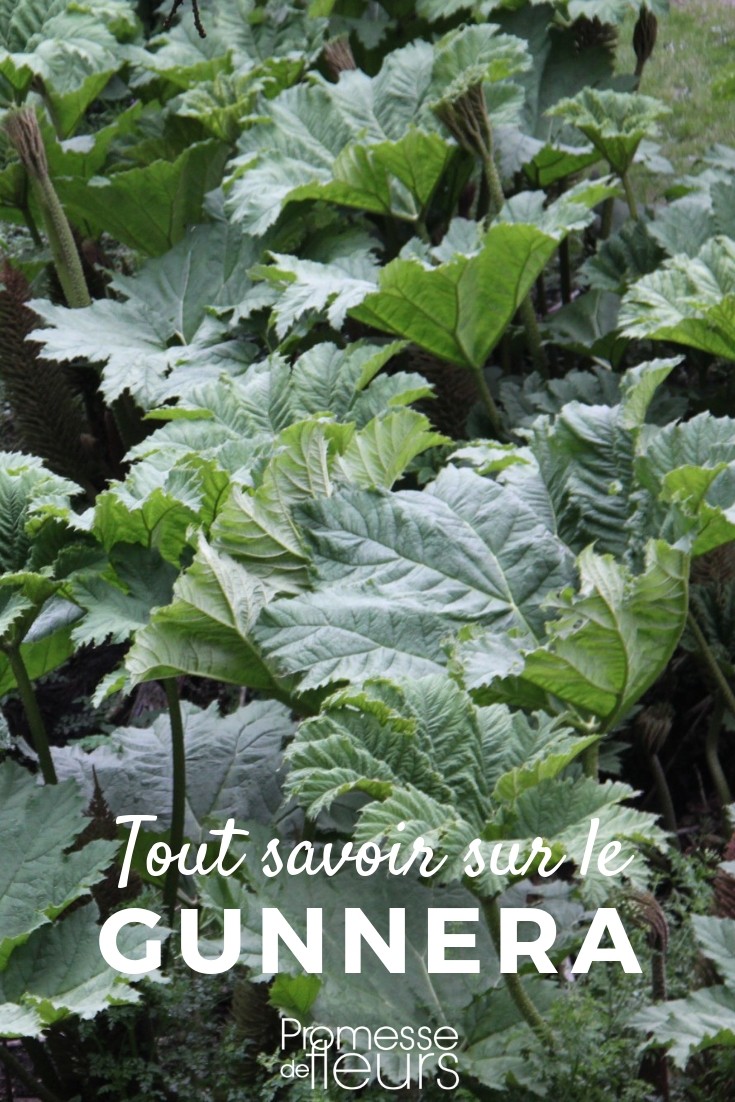


































Comments